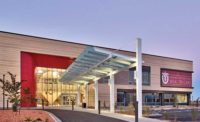The Utah Transit Authority is applying lessons learned from its first rail projects to create one of the country's largest and most aggressive rail expansions. The $2.8-billion program, dubbed "FrontLines 2015," aims to add 70 miles of light and commuter rail to UTA's existing 65-mile network in seven years.
FrontLines was conceived as a long-range plan with build-out expected by 2030. However, regional leaders suggested cutting the schedule in half, and in 2006, voters approved a sales tax increase to accelerate the plan.
The UTA rose to the challenge, managing a complex web of stakeholders that included the Utah Dept. of Transportation, the Union Pacific Railroad, multiple municipalities and property owners adjacent to rail lines. As with past projects, the UTA partnered with local governments and agencies in the planning process, practicing what it calls "construction alliancing," where those involved share the risks and benefits, according to Mike Allegra, UTA general manager.
The program will add new light rail TRAX lines— the Mid-Jordan, West Valley City, Draper and the Salt Lake International Airport lines—and a 45-mile extension of the commuter rail FrontRunner south line to Provo. In addition, construction should start this year on the program's $55.5-million street car line, the first in Utah since the early 1990s, in Salt Lake City's Sugar House Business District. Other improvements include a new welcome center at the airport and a pedestrian- and bicycle-friendly "Great Street" along North Temple Street in downtown Salt Lake City. Completion for the entire program is expected by the end of 2015.
Now in its fifth year, the expansion is nearly 90% complete, with two of five rail lines already operational.
One Team, One Goal
The Mid-Jordan and West Valley City lines, collectively 16 miles, opened to the public in August, a year ahead of schedule and roughly 20% under budget. If all continues as expected, the whole program should come out below budget, with total costs around $2.4 billion, Allegra says.
"This project has been successful because of the willingness and understanding of everyone involved to take off their respective agency hats and work together as one team toward one goal," he says. "Through our partnerships, we have been able to spur creativity that has led to significant savings in time and money."
In one case, Salt Lake City helped UTA resolve a right-of-way dispute by swapping properties with a parking-lot owner. The city contributed an abandoned city-owned lot, the parking lot owner agreed to move and the UTA paved the lot for the owner. What could have been an expensive problem was resolved "for pennies," Allegra says.
Meeting the aggressive schedule was made even more challenging when the economy crumbled, leaving a $550-million loss in sales tax revenue needed for the project. While federal grants covered the majority of the costs for the Mid-Jordan line and Draper extension, the other three lines—West Valley, Airport and FrontRunner to Provo—rely on 100% local funding from the sales taxes generated by the 2006 tax increase.
Lower material costs and competitive bids offset some of the shortfall, and sequencing minimized expensive standby periods by allowing as much work as possible to be done out of order to keep crews busy. The faster pace of completion reduced extended overhead costs, but in doing so, created other funding challenges, says Steve Meyers, UTA's chief capital development officer.
"We've had huge cash flow issues on this project," Meyer says. "It's been a team effort to manage our resources. Contractors have financed a portion of their cost and deferred some of their payments. We've bonded a lot more than originally anticipated and had to use money previously dedicated for ongoing operations to manage cash flow on the projects.
"It will take some long-term and short-term borrowing, but we're making the numbers work," Meyer adds.
Multiple Innovations







Post a comment to this article
Report Abusive Comment